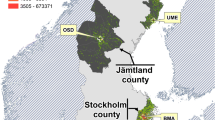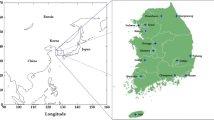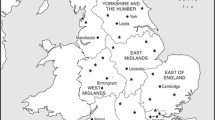Abstract
Spatial synoptic classification (SSC) is here first employed in assessing heat-related mortality and morbidity in Central Europe. It is applied for examining links between weather patterns and cardiovascular (CVD) mortality and morbidity in an extended summer season (16 May–15 September) during 1994–2009. As in previous studies, two SSC air masses (AMs)—dry tropical (DT) and moist tropical (MT)—are associated with significant excess CVD mortality in Prague, while effects on CVD hospital admissions are small and insignificant. Excess mortality for ischaemic heart diseases is more strongly associated with DT, while MT has adverse effect especially on cerebrovascular mortality. Links between the oppressive AMs and excess mortality relate also to conditions on previous days, as DT and MT occur in typical sequences. The highest CVD mortality deviations are found 1 day after a hot spell’s onset, when temperature as well as frequency of the oppressive AMs are highest. Following this peak is typically DT- to MT-like weather transition, characterized by decrease in temperature and increase in humidity. The transition between upward (DT) and downward (MT) phases is associated with the largest excess CVD mortality, and the change contributes to the increased and more lagged effects on cerebrovascular mortality. The study highlights the importance of critically evaluating SSC’s applicability and benefits within warning systems relative to other synoptic and epidemiological approaches. Only a subset of days with the oppressive AMs is associated with excess mortality, and regression models accounting for possible meteorological and other factors explain little of the mortality variance.






Similar content being viewed by others
References
Act No. 201/2012 Coll., on ambient air protection. Approved on 02 May 2012 by the Parliament of the Czech Republic
Arnfield AJ (2003) Two decades of urban climate research: a review of turbulence, exchanges of energy and water, and the urban heat island. Int J Climatol 23:1–26. doi:10.1002/joc.859
Basu R (2009) High ambient temperature and mortality: a review of epidemiologic studies from 2001 to 2008. Environ Heal 8:1–13
Ballester J, Rodó X, Giorgi F (2009) Future changes in Central Europe heat waves expected to mostly follow summer mean warming. Clim Dyn 35:1191–1205. doi:10.1007/s00382-009-0641-5
Barriopedro D, Fischer EM, Luterbacher J, Trigo RM, García-Herrera R (2011) The hot summer of 2010: redrawing the temperature record map of Europe. Science 332:220–224. doi:10.1126/ science.1201224
Barnett AG, Tong S, Clements ACA (2010) What measure of temperature is the best predictor of mortality? Environ Res 110:604–611. doi:10.1016/j.envres.2010.05.006
Bower D, Mcgregor GR, Hannah M, Sheridan SC (2007) Development of a spatial synoptic classification scheme for western Europe. Int J Climatol 27:2017–2040. doi:10.1002/joc
Christidis N, Donaldson GC, Stott PA (2010) Causes for the recent changes in cold- and heat-related mortality in England and Wales. Clim Chang 102:539–553. doi:10.1007/s10584-009-9774-0
Davis RE, Kalkstein LS (1990) Development of an automated spatial synoptic climatological classification. Int J Climatol 10:769–794
Davídkovová H, Kyselý J, Kříž B, Vojtíšek P, Bobák M (2013) Trends in cardiovascular mortality and hospitalisations, and potential contribution of inhospital case-fatality rates to changes in national mortality in the Czech Republic 1994–2009. Heart 99:409–416. doi:10.1136/heartjnl-2012-303123
Davídkovová H, Plavcová E, Kynčl J, Kyselý J (2014) Impacts of hot and cold spells differ for acute and chronic ischaemic heart diseases. BMC Public Health 14:480. doi:10.1186/1471-2458-14-480
D’Ippoliti D, Michelozzi P, Marino C, de’Donato F, Menne B, Katsouyanni K, Kirchmayer U, Analitis A, Medina-Ramón M, Paldy A, Atkinson R, Kovats S, Bisanti L, Schneider A, Lefranc A, Iñiguez C, Perucci CA (2010) The impact of heat waves on mortality in 9 European cities: results from the EuroHEAT project. Environ Heal 9:37
Ebi KL, Teisberg TJ, Kalkstein LS, Robinson L, Weiher RF (2004) Heat watch/warning systems save lives: estimated costs and benefits for Philadelphia 1995–1998. B Am Meteorol Soc 85:1067–1073
Ebi KL (2014) Health in the new scenarios for climate change research. Int J Environ Res Public Health 11:30–46. doi:10.3390/ijerph110100030
EEA (2010) Mapping the impacts of natural hazards and technological accidents in Europe. European Environment Agency (EEA) Technical Report No. 13/2010. 144 pp. ISBN 978–92–9213–168–5
Gabriel KMA, Endlicher WR (2011) Urban and rural mortality rates during heat waves in Berlin and Brandenburg, Germany. Environ Pollut 159:2044–2050. doi:10.1016/j.envpol.2011.01.016
Gosling SN, Lowe JA, McGregor GR, Pelling M, Malamud BD (2009) Associations between elevated atmospheric temperature and human mortality: a critical review of literature. Clim Chang 92:299–341. doi:10.1007/s10584-008-9441-x
Guo Y, Barnett AG, Yu W, Pan X, Ye X, Huang C, Tong S (2011) A large change in temperature between neighbouring days increases the risk of mortality. PLoS One 6:e16511. doi: 10.1371/journal.pone.0016511
Hajat S, Kovats RS, Lachowycz K (2007) Heat-related and cold-related deaths in England and Wales: who is at risk? Occup Environ Med 64:93–100. doi:10.1136/oem.2006.029017
Hajat S, Sheridan SC, Allen MJ, Pascal M, Laaidi K., Yagouti A., Bickis U, Tobias A, Bourque D, Armstrong BG, Kosatsky T (2010) Heat-health warning systems: a comparison of the predictive capacity of different approaches to identifying dangerously hot days. Amer J Pub Health 100:1137–1144.
Hanzlíková H, Plavcová E, Kynčl J, Kříž B, Kyselý J (2015) Contrasting patterns of hot spell effects on morbidity and mortality for cardiovascular diseases in the Czech Republic, 1994–2009. Int J Biometeorol. doi:10.1007/s00484-015-0974-1
Hattis D, Ogneva-Himmelberger Y, Ratick S (2012) The spatial variability of heat-related mortality in Massachusetts. Appl Geogr 33:45–52. doi:10.1016/j.apgeog.2011.07.008
Hondula DM, Vanos JK, Gosling SN (2014) The SSC: a decade of climate-health research and future directions. Int J Biometeorol 58:109–120. doi:10.1007/s00484-012-0619-6
Höppe P (1999) The physiological equivalent temperature, a universal index for the biometeorological assessment of the thermal environment. Int J Biometeorol 43:71–75
Huynen MM, Martens P, Schram D, Weijenberg MP, Kunst AE (2001) The impact of heat waves and cold spells on mortality rates in the Dutch population. Environ Health Persp 109(5):463–470
IPCC (2014) Summary for policymakers. In: Climate Change 2014: impacts, adaptation, and vulnerability. Part A: Global and sectoral aspects. Contribution of Working Group II to the Fifth Assessment Report of the Intergovernmental Panel on Climate Change [Field CB, Barros VR, Dokken DJ, Mach KJ, Mastrandrea MD, Bilir TE, Chatterjee M, Ebi KL, Estrada YO, Genova RC, Girma B, Kissel ES, Levy AN, MacCracken S, Mastrandrea PR, White LL (eds.)]. Cambridge University Press, Cambridge, United Kingdom and New York, NY, USA, pp. 1–32.
Jendritzky G, de Dear R, Havenith G (2012) UTCI—why another thermal index? Int J Biometeorol 56:421–428. doi:10.1007/s00484-011-0513-7
Kalkstein LS, Corrigan PR (1986) A synoptic climatological approach for geographical analysis: assessment of sulfur dioxide concentrations. Ann Assoc Am Geogr 76:381–395
Kalkstein LS, Jamason PF, Greene JS, Libby J, Robinson L (1996) The Philadelphia hot weather-health watch/warning system: development and application, summer 1995. Bull Am Meteorol Soc 77:1519–1528
Kenney WL, Munce TA (2003) Invited review: aging and human temperature regulation. J Appl Physiol 95:2598–2603. doi:10.1152/japplphysiol.00202.2003
Kosatsky T (2005) The 2003 European heat waves. Eurosurveillance 10(7):148–149
Kottek M, Grieser J, Beck C, Rudolf B, Rubel F (2006) World map of the Köppen-Geiger climate classification updated. Meteorol Zeitschrift 15:259–263. doi:10.1127/0941-2948/2006/0130
Kovats RS, Hajat S, Wilkinson P (2004) Contrasting patterns of mortality and hospital admissions during hot weather and heat waves in Greater London, UK. Occup Environ Med 61:893–898. doi:10.1136/oem.2003.012047
Kirch W, Menne B, Bertollini R (2005) Extreme weather events and public health responses. World Health Organization. Springer, Berlin, pp 13–23. ISBN 3-540-24417-4.
Knowlton K, Rotkin-Ellman M, King G, Margolis HG, Smith D, Solomon G, Trent R, English P (2009) The 2006 California heat wave: impacts on hospitalizations and emergency department visits. Environ Health Perspect 117:61–67. doi:10.1289/ehp.11594
Kyobutungi C, Grau A, Stieglbauer G, Becher H (2005) Absolute temperature, temperature changes and stroke risk: a case-crossover study. Eur J Epidemiol 20:693–698. doi:10.1007/s10654-005-0703-x
Kyselý J (2004) Mortality and displaced mortality during heat waves in the Czech Republic. Int J Biometeorol 49(2):91–97
Kyselý J, Huth R (2004) Heat-related mortality in the Czech Republic examined through synoptic and 'traditional' approaches. Clim Res 25(3):265–274
Kyselý J, Huth R (2010) Relationships between summer air masses and mortality in Seoul: Comparison of weather-type classifications. Phys Chem Earth 35:536–543. doi:10.1016/j.pce.2009.11.001
Kyselý J, Huth R, Kim J (2010) Evaluating heat-related mortality in Korea by objective classifications of “air masses”. Int J Climatol 30:1484–1501
Kyselý J, Plavcová E, Davídkovová H, Kynčl J (2011) Comparison of hot and cold spell effects on cardiovascular mortality in individual population groups in the Czech Republic. Clim Res 49(2):113–129
Kyselý J, Plavcová E (2012) Declining impacts of hot spells on mortality in the Czech Republic, 1986–2009: adaptation to climate change? Clim Chang 113:437–453. doi:10.1007/s10584-011-0358-4
Larsen J (2006) Setting the record straight: more than 52,000 Europeans died from heat in summer 2003. Earth Policy Institut http://wwwearth- policyorg/plan_b_updates/2006/update56 accessed December 7, 2014.
Lee CC (2015) A systematic evaluation of the lagged effects of spatiotemporally relative surface weather types on wintertime cardiovascular-related mortality across 19 US cities. Int J Biometeorol 1-13
Lin H, Zhang Y, Xu Y, Liu T, Luo Y, Xiao J, Wu W, Ma W (2013) Temperature changes between neighboring days and mortality in summer: a distributed lag non-linear time series analysis. PLoS One 8:e66403. doi: 10.1371/journal.pone.0066403.
Linares C, Díaz J (2008) Impact of high temperatures on hospital admissions: comparative analysis with previous studies about mortality (Madrid). Eur J Pub Health 18:317–322. doi:10.1093/eurpub/ ckm108
Loughnan ME, Nicholls N, Tapper NJ (2008) Demographic, seasonal, and spatial differences in acute myocardial infarction admissions to hospital in Melbourne Australia. Int J Health Geogr 7:42. doi:10.1186/1476-072X-7-42
Loughnan ME, Tapper NJ, Phan T, Lynch K, McInnes JA (2013) A spatial vulnerability analysis of urban populations during extreme heat events in Australian capital cities. National Climate Change Adaptation Research Facility, Gold Coast, 128 pp http://wwwnccarfeduau/publications/spatial-vulnerability-urban-extreme-heat-events accessed December 7, 2014.
Mastrangelo G, Fedeli U, Visentin C, Milan G, Fadda E, Spolaore P (2007) Pattern and determinants of hospitalization during heat waves: an ecologic study. BMC Public Health 7:200. doi:10.1186/ 1471-2458-7-200
Matzarakis A, Mayer H, Iziomon MG (1999) Applications of a universal thermal index: physiological equivalent temperature. Int J Biometeorol 43:76–84
Matzarakis A, Muthers S, Koch E (2010) Human biometeorological evaluation of heat-related mortality in Vienna. Theor Appl Climatol 105:1–10. doi:10.1007/s00704-010-0372-x
Muthers S, Matzarakis A, Koch E (2010) Climate change and mortality in Vienna—a human biometeorological analysis based on regional climate modeling. Int J Environ Res Public Health 7:2965–2977
O’Neill MS, Carter R, Kish JK, Gronlund CJ, White-Newsome JL, Manarolla X, Zanobetti A, Schwartz JD (2009) Preventing heat-related morbidity and mortality: new approaches in a changing climate. Maturitas 64:98–103
Plavcová E, Kyselý J (2010) Relationships between sudden weather changes in summer and mortality in the Czech Republic, 1986–2005. Int J Biometeorol 54:539–551. doi:10.1007/s00484-010-0303-7
Schwartz J, Samet JM, Patz JA (2004) Hospital admissions for heart disease the effects of temperature and humidity. Epidemiology 15(6):755–761. doi:10.1097/01.ede.0000134875.15919.Of
Semenza JC, Rubin CH, Falter KH, Selanikio JD, Flanders WD, Howe HL, Wilhelm JL (1996) Heat-related deaths during the July 1995 heat wave in Chicago. New Engl J Med 335:84–90
Semenza JC, McCullough JE, Flanders WD, McGeehin MA, Lumpkin JR (1999) Excess hospital admission during the July 1995 heat wave in Chicago. Am J Prevent Med 16:269–277
Sheridan SC (2002) The redevelopment of a weather-type classification scheme for North America. Int J Climatol 22:51–68
Sheridan SC, Dolney TJ (2003) Heat, mortality, and level of urbanization: measuring vulnerability across Ohio, USA. Clim Res 24:255–265
Sheridan SC, Kalkstein LS (2004) Progress in heat watch-warning system technology. B Am Meteorol Soc 85:1931–1942
Smoyer KE, Kalkstein LS, Greene JS, Ye H (2000) The impacts of weather and pollution on human mortality in Birmingham, Alabama and Philadelphia, Pennsylvania. Int J Climatol 20:881–897
Tan J, Kalkstein L, Huang J, Lin S, Yin H, Shao D (2004) An operational heat/health warning system in Shanghai. Int J Biometeorol 48:157–162. doi:10.1007/s00484-003-0193-z
Toloo GS, Fitzgerald G, Aitken P, Verrall K, Tong S (2013) Are heat warning systems effective? Environ Heal 12:27. doi:10.1186/1476-069X-12-27
Urban A, Davídkovová H, Kyselý J (2014) Heat- and cold-stress effects on cardiovascular mortality and morbidity among urban and rural populations in the Czech Republic. Int J Biometeorol 58:1057–1068. doi:10.1007/s00484-013-0693-4
Urban A, Kyselý J (2014) Comparison of UTCI with other thermal indices in the assessment of heat and cold effects on cardiovascular mortality in the Czech Republic. Int J Environ Res Public Health 11:952–967. doi:10.3390/ijerph110100952
Vanos JK, Cakmak S (2014) Changing air mass frequencies in Canada: potential links and implications for human health. Int J Biometeorol 58:121–135. doi:10.1007/s00484-013-0634-2
Vanos JK, Cakmak S, Kalkstein LS, Yagouti A (2014) Association of weather and air pollution interactions on daily mortality in 12 Canadian cities. Air Qual Atmos Heal. doi:10.1007/s11869-014-0266-7
Venables WN, Ripley BD (2002) Modern Applied Statistics with S. Springer, Fourth edition
Weihs P, Staiger H, Tinz B, Batchvarova E, Rieder H, Vuilleumier L, Maturilli G, Jendritzky G (2012) The uncertainty of UTCI due to uncertainties in the determination of radiation fluxes derived from measured and observed meteorological data. Int J Biometeorol 56:537–555. doi:10.1007/s0048-011-0416-7
Whitman S, Good G, Donoghue ER, Benbow N, Shou WY, Mou SX (1997) Mortality in Chicago attributed to the July 1995 heat wave. Am J Pub Health 87:1515–1518
Ye X, Wolff R, Yu W, Vaneckova P, Pan X, Tong S (2012) Ambient temperature and morbidity: a review of epidemiological evidence. Environ Health Perspect 120:19–28. doi:10.1289/ehp.1003198
Zacharias S, Koppe C, Mücke H-G (2014) Influence of heat waves on ischemic heart diseases in Germany. Climate 2:133–152. doi:10.3390/cli2030133
Zhang K, Rood RB, Michailidis G, Oswald EM, Schwartz JD, Zanobetti A, Ebi KL, O'Neill MS (2012) Comparing exposure metrics for classifying “dangerous heat” in heat wave and health warning systems. Environ Int 46:23–29. doi:10.1016/j.envint.2012.05.001
Acknowledgments
The study was supported by the Czech Science Foundation, project P209/11/1985 and the Charles University Grant Agency, project no. 3300-243-227 249. Thanks are due to Bohumír Kříž and Jan Kynčl, National Institute of Public Health, and Hana Davídkovová, Institute of Atmospheric Physics CAS, for preparing epidemiological datasets as well as for useful discussions concerning their interpretation and to Zuzana Rulfová, Institute of Atmospheric Physics CAS, for the assistance in drawing Fig. 1. Thanks go also to the anonymous reviewers whose valuable comments improved the original manuscript. Data were provided by the Institute of Health Information and Statistics, the Czech Statistical Office and the Czech Hydrometeorological Institute.
Author information
Authors and Affiliations
Corresponding author
Rights and permissions
About this article
Cite this article
Urban, A., Kyselý, J. Application of spatial synoptic classification in evaluating links between heat stress and cardiovascular mortality and morbidity in Prague, Czech Republic. Int J Biometeorol 62, 85–96 (2018). https://doi.org/10.1007/s00484-015-1055-1
Received:
Revised:
Accepted:
Published:
Issue Date:
DOI: https://doi.org/10.1007/s00484-015-1055-1




